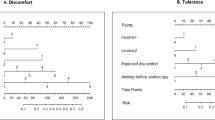Abstract
Our purpose in this study was to determine if the use of an instrument developed by our group to direct sedation choice improves patient satisfaction with endoscopy sedation compared to standard sedation practice. After 200 enrollments, data were available for 194 patients who completed the study. There were nine cases of dissatisfaction: five (5%) in the control group and four (4%) in the intervention group (P = 0.78). The 95% confidence intervals (1%–10%) were almost identical, indicating no difference between groups. The study was stopped after an interim analysis showed no significant difference in satisfaction between the groups. This could have been because the assumption that patients with increased risk of dissatisfaction do better with deeper sedation is incorrect. Another explanation could be the increased awareness of the value of benzodiazepines in endoscopy. Consistent with our findings, nervousness rather than pain predicted dissatisfaction, and the optimal use of anxiolytics with amnesic properties may be comparable to that of propofol.
Similar content being viewed by others
References
Everhart JE (1994) Overview. In: Digestive diseases in the United States: epidemiology and impact. NIH Publication 94-1447. Everhart JE (ed). U.S. Department of Health and Human Services, Public Health Service, National Institutes of Health, Bethesda, MD, pp 3–53
Froehlich F, Thorens J, Schwizer W, et al. (1997) Sedation and analgesia for colonoscopy: patient tolerance, pain, and cardiorespiratory parameters. Gastrointest Endosc 45:1–9
Linn LS, Greenfield S (1982) Patient suffering and patient satisfaction among the chronically ill. Med Care 20:425–431
Raymond JM, Michel P, Beyssac R, et al. (1996) Patient’s opinion following an upper digestive endoscopy in ambulatory care: results of a national survey (II). Gastroenterol Clin Biol 20:570–574
Ciriza C, Garcia L, Fernadez A, Diez A, Delgado M, San Sebastian AI (2001) Sedation for gastrointestinal endoscopy. Analysis of tolerance and complications. Rev Esp Enferm Dig 93(9):587–597
Schutz Sm, Lee LG, Scmitt Cm, Almon M, Baillie J (1994) Clues to patient dissatisfaction with conscious sedation for colonoscopy. Am J Gastroenterol 98(9):1476–1483
Waye JD (1999) Perspectives. “International Editorial Board”. Gastrointest Endosc 50(6):889–890
Ware JE, Snyder MK, Wright WR (1998) Development and validation of scale to measure patient satisfaction with health care services. Vol 1, Part B. National Technical Information, Springfield, VA
Linder-Pelz S (1982) Social psychological determinants of patient satisfaction: a test of five hypotheses. Soc Sci Med 15:583–589
Greenley JR, Young TB, Schoenheor RA (1982) Psychological distress and patient satisfaction. Med Care 20(4):373–385
Morgan I, Roufeil L, Kaushik S, Bassett M (1998) Influence of coping style and pre-colonoscopy information on pain and anxiety of colonoscopy. Gastrointest Endosc 48(2):119–127
Yacavone RF, Locke GR, Gostout CJ, Rockwood TH, Thieling S, Zinsmeister AR (2001) Factors influencing patient satisfaction with GI endoscopy. Gastrointest Endosc 53(7):703–710
Pena LR, Mardini H, Nickl N (2005) Development of an instrument to assess and predict satisfaction and poor tolerance among patients undergoing endoscopic procedures. Dig Dis Sci 50(10):1860–1871
Acknowledgments
This work was supported, in part, by a generous 2-year grant from the American Society for Gastrointestinal Endoscopy (ASGE). Special thanks go to Dr. Edwin A. Bowe, Jr., and the faculty of the Anesthesia Department, University of Kentucky, for their invaluable collaboration, which made this study possible. We thank our study coordinators, Sylvia Nicholson and Sarah Turner, for their hard work.
Author information
Authors and Affiliations
Corresponding author
Rights and permissions
About this article
Cite this article
Peña, L.R., Mardini, H. & Nickl, N. An Instrument to Predict Endoscopy Tolerance: A Prospective Randomized Study. Dig Dis Sci 52, 2888–2891 (2007). https://doi.org/10.1007/s10620-007-9797-1
Received:
Accepted:
Published:
Issue Date:
DOI: https://doi.org/10.1007/s10620-007-9797-1




